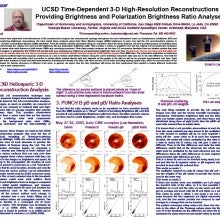UCSD Time-Dependent 3-D High-Resolution Reconstructions Providing Brightness and Polarization Brightness Ratio Analyses
Bernard
Jackson
Department of Astronomy and Astrophysics, University of California, San Diego, 9500 Gilman Drive #0424, La Jolla, CA 92093-0424, USA
Matthew Bracamontes, Department of Astronomy and Astrophysics, University of California, San Diego, 9500 Gilman Drive #0424, La Jolla, CA 92093-0424, USA
Andrew Buffington, Department of Astronomy and Astrophysics, University of California, San Diego, 9500 Gilman Drive #0424, La Jolla, CA 92093-0424, USA
Dusan Odstrcil, George Mason University, Fairfax, Virginia and NASA Goddard Spaceflight Center, Greenbelt, Maryland, USA
Andrew Buffington, Department of Astronomy and Astrophysics, University of California, San Diego, 9500 Gilman Drive #0424, La Jolla, CA 92093-0424, USA
Dusan Odstrcil, George Mason University, Fairfax, Virginia and NASA Goddard Spaceflight Center, Greenbelt, Maryland, USA
Poster
UCSD’s iterative time dependent three-dimensional (3-D) reconstruction program has characterized topology throughout the inner heliosphere based on interplanetary scintillation (IPS) and Thomson scattering brightness observations. We have tested these analyses using Solar Mass Ejection Imager (SMEI) brightness to learn how well the 3-D reconstructions perform to reproduce a known Coronal Mass Ejection (CME) simulation. From the density volumes generated using our volumetric data from these analyses, we have provided pseudo (or imitation) lines of sight (LoS) through the volume over time in both brightness (B) and polarization brightness (pB). This provides a means to establish how well the original 3-D reconstruction technique reproduces known solar wind features of both known CMEs and corotating structures. From these pseudo analyses we can then 3-D reconstruct densities from our iterative system that uses this type of imagery. In anticipation that PUNCH will provide both near-simultaneous brightness and polarization brightness data over time, We announce that we now have used this pB/B ratio analysis from our pseudo data sets over time to accurately reproduce volumetric density structure using the UCSD iterative process from SMEI data. The polarization brightness to brightness ratio of Thomson-scattered light has long been understood as a way to isolate small distinct features along the LoS in individual volumetric data sets due to the ratio difference. How well the UCSD iterative system will accurately work in practice to isolate whole volume density data sets depends on the quality of the data as well as its accurate measurement over time. Tests continue with these analyses to learn how well measurements of background density over time, and other sources of LoS noise including missing spatial data, affect the reconstruction of the density volumes for density structures of different scale sizes. In general, we expect that the ratio technique will lessen the flow requirement time needed to isolate different small-scale structures due to their outward flow.

Poster PDF
Meeting homepage